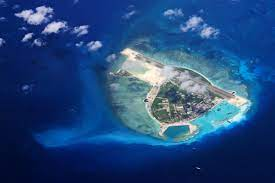The United States conducted a joint naval sail with the Philippines in the South China Sea on Monday, an obvious provocative move considering the tensions between China and the Philippines over the Ren’ai Reef dispute.

A Reuters report citing the Armed Forces of the Philippines’ Western Command said it was the first time Manila and Washington have carried out a joint sail in the waters west of Palawan island. Perhaps the joint sail, apart from underscoring the Philippines’ military alliance with the US, was also meant to assert its baseless claims over the disputed waters.
The reckless act to hype the maritime dispute coincides with this week’s series of meetings in Jakarta, Indonesia, with the Association of Southeast Asian Nations taking center stage. The US, which has for years used the maritime disputes in the South China Sea to interfere in regional affairs, apparently intends to heighten tensions again so it can fish in troubled waters to fulfill its strategic goals.
The farce the US staged with the Philippines is yet another proof of Washington posing the biggest threat to peace and stability in the South China Sea. To cater to its own strategic needs and maintain its global hegemony, the US is turning the sea into a playground for major power competition, totally disregarding the regional countries’ quest for peace, stability and development.
In order to address issues of common concern, ASEAN has tried to play down geopolitics in the meetings in Jakarta. Many of the bloc’s members have either refused or are reluctant to take sides in the China-US disputes, because they know that doing so would sow the seeds of division in the region.
China and ASEAN are in the middle of negotiations to finalize a Code of Conduct for the South China Sea, which is aimed at maintaining lasting peace and stability in the waters. And the two sides have the wisdom and capacity to resolve their maritime differences and disputes.
The South China Sea is one of the world’s busiest waterways with some 100,000 merchant vessels sailing through its waters every year. Any disturbance in the waters will disrupt the free and smooth flow of goods and global supply chains, slowing down the region’s development.
Hence, instead of indulging in selfish calculations and stirring up trouble in the South China Sea, the US should play a constructive role in the region, because peace and stability serves its own interest too. It should heed the call of the countries in the region and respect their efforts to turn the South China Sea into a sea of peace, friendship and cooperation.